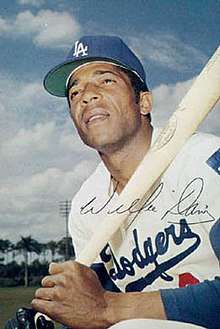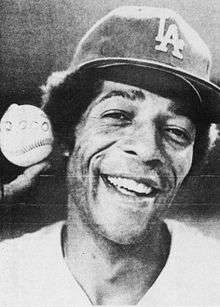Willie Davis (baseball)
William Henry Davis (April 15, 1940 – March 9, 2010) was a center fielder in Major League Baseball who played most of his career for the Los Angeles Dodgers. At the end of his career he ranked seventh in major league history in putouts (5449) and total chances (5719) in the outfield, and third in games in center field (2237). He was ninth in National League history in total outfield games (2274), and won Gold Glove Awards from 1971 to 1973. He had 13 seasons of 20 or more stolen bases, led the NL in triples twice, and retired with the fourth most triples (138) by any major leaguer since 1945. He holds Los Angeles club records (1958–present) for career hits (2091), runs (1004), triples (110), at bats (7495), total bases (3094) and extra base hits (585). His 31-game hitting streak in 1969 remains the longest by a Dodger. When he tied Zack Wheat's previous record at 29 games, the message board at Dodger Stadium flashed a message sent via telegram by Wheat from his home in Missouri, saying, "Congratulations. Keep going. You have done a good job. Good luck."[1]
| Willie Davis | |||
|---|---|---|---|
 | |||
| Center fielder | |||
| Born: April 15, 1940 Mineral Springs, Arkansas | |||
| Died: March 9, 2010 (aged 69) Burbank, California | |||
| |||
| Professional debut | |||
| MLB: September 8, 1960, for the Los Angeles Dodgers | |||
| NPB: April 2, 1977, for the Chunichi Dragons | |||
| Last appearance | |||
| MLB: September 30, 1979, for the California Angels | |||
| NPB: September 30, 1978, for the Crown Lighter Lions | |||
| MLB statistics | |||
| Batting average | .279 | ||
| Hits | 2,561 | ||
| Home runs | 182 | ||
| Runs batted in | 1,053 | ||
| Stolen bases | 398 | ||
| NPB statistics | |||
| Batting average | .297 | ||
| Home runs | 43 | ||
| Runs batted in | 132 | ||
| Teams | |||
| |||
| Career highlights and awards | |||
Career
As a youngster, Davis moved to Los Angeles, where he was a three-sport standout in baseball, basketball, and track & field at Theodore Roosevelt High School. He once ran a 9.5-second 100-yard dash, and set a city record in the long jump of 25 feet 5 inches (7.75 m).[2] Discovered by the Dodgers scout, Kenny Myers, Davis signed with the ballclub upon graduating from Roosevelt in 1958.[3] While playing for Reno, he scored from first base on a single nine times in one season.
Davis played his first game with the Los Angeles Dodgers in 1960. The following season he replaced the former All-Star Duke Snider in center field, where Davis stayed for 13 years. Widely considered to be one of the fastest baseball players of the 1960s, Davis had 20 or more stolen bases in eleven consecutive seasons, with a career-high 42 in 1964. Along with Maury Wills, Davis provided footspeed at the top of Dodgers' lineup. In 1962, these two players "set the table" for teammate Tommy Davis to lead the National League with 153 runs batted in (RBI), a Los Angeles Dodgers single-season record. Willie Davis, along with Maury Wills, was a key part of the Dodgers' National League titles in 1963, 1965, and 1966.
In 1962, Davis batted .285 with 85 runs batted in, posting career highs in home runs (21), runs (103), and hits (171). In that same season, Davis and Wills set a National League record for stolen bases by two teammates in season with 136 (Wills with 104 and Davis with 32). 1962 was the first of two seasons that Davis would lead the National League in triples.[4] It was the first of two seasons that he would tally double-figure totals in doubles, triples, home runs, and stolen bases.[4]
Davis was a part of two World Series championship teams, in 1963 and 1965. In the 1963 World Series He knocked in the game winning run with a 1st inning 2 run double in game 2 and in game 4 the game that clinched the World Series, he hit the game winning RBI with a Sacrifice Fly in the 7th Inning. In the 1965 World Series, Davis set a record (since broken) of three stolen bases (including one during which he stumbled and fell, the pitcher hesitated throwing to first base, and Davis literally crawled into second base safely) in a single game.
Davis committed a World Series record three errors on two consecutive plays, in the fifth inning of Game Two of the 1966 World Series.[5] First, he lost Paul Blair's fly ball in the sun for a two-base error. One batter later, he dropped Andy Etchebarren's fly ball. When he recovered the Etchebarren ball, Davis threw it over third base, allowing Boog Powell and Blair to score. When questioned after the game, he said, "Even when you can't see the ball you have to take a stab at it, I couldn't see the ball in the sun." The Orioles swept the Dodgers, four games to none. The Dodgers did not score a run in Game Two, Game Three, or Game Four. In Game Four, Davis made a leaping catch at the centerfield fence, robbing Powell of a home run.
Davis batted a career-high .311 in 1969. His 31-game hitting streak that year, from August 1 to September 3, was the longest in the major leagues since 1949, when Dom DiMaggio hit in 34 straight. Davis' streak broke the previous franchise record of 29, set in 1916 by Zack Wheat. Davis was named NL Player of the Month of August with a .459 batting average. During the streak, his season average climbed from .260 to .316.
In 1970, Davis batted .305, posting career highs in triples (16) and RBI (93). His 16 triples led all major league players, and was the second time he led the National League in triples.[4]
He ended 1971 with career highs in doubles (33) and total bases (281). He batted .309, his third straight season topping .300. For the second time, he posted double-figure totals in doubles, triples, home runs and stolen bases. Davis was selected for his first (of two) National League All-Star team in 1971. He was awarded his first (of three) Gold Glove award.[4]
Davis won three consecutive Gold Glove awards, 1971 through 1973. He was the first National League outfielder who threw left-handed to be so honored, and just the second in Major League history (the first was Vic Davalillo, who won an American League Gold Glove in 1964). For his career, Davis led the NL in putouts by an outfielder twice, in 1964 and 1971. He led NL center fielders in assists twice, in 1963 and 1964. He led NL center fielders in fielding percentage twice, in 1970 and 1976. He also led centerfielders in errors five times, in 1962, 1963, 1965, 1968, and 1974.[4]
In two All-Star games, 1971 and 1973, he batted a combined 3-for-3, with a home run off Nolan Ryan.
After the 1973 season, Davis was traded to the Montreal Expos for relief pitcher Mike Marshall, who would win the Cy Young Award in 1974. Davis batted .295 for Montreal before being traded to the Texas Rangers in December 1974. Davis batted just .249 for the Rangers in 42 games in 1975 before finishing the season with the St. Louis Cardinals, batting .291. In 1976 he batted .268 for the San Diego Padres, and then he spent two years in Japan with the Chunichi Dragons and Crown Lighter Lions.[6]

Legacy and post-baseball
During his time playing for LA Dodgers in Los Angeles during the early 1960s, he met Jeanna LemYou . They married on September 5th 1963, while married, Davis adopted Jeanne's son, Gregory Chapman Davis, from a previous marriage. Jeanna and Davis had two daughters during their marriage, Kimberly Davis born in 1964 and Jennifer Davis born in 1967. After many happy years together, they divorced in 1975. Davis also had another son by the name Shonan Casey Davis, together with Amy Rumbelow, his second wife.
A convert to Buddhism via his marriage to Jeanna, Davis constantly fingered his prayer beads and chanted before games.[7] He played his final major league season with the California Angels in 1979, making two pinch-hitting appearances in the American League Championship Series before retiring. In an 18-year career, Davis accumulated a .279 batting average with 182 home runs and 1053 RBI in 2429 games. He also collected 2561 hits and 398 stolen bases. His total of 2237 games in center field ranks behind only Willie Mays (2827) and Tris Speaker (2690) in major league history. In addition to the Los Angeles records he retains, his club mark of 1952 games was surpassed by Bill Russell in 1984; Steve Garvey broke his records of 849 RBI and 321 doubles in 1981 and 1982 respectively. Garvey and Ron Cey passed his Los Angeles club record of 154 home runs in 1979; Davis' record for left-handed hitters was broken by Shawn Green in 2004.
Davis also appeared in several TV programs, including Mr. Ed, The Flying Nun, and Owen Marshall: Counselor at Law, and was a co-star of the Jerry Lewis comedy film from 1970, Which Way to the Front?. In a 1969 episode of Bewitched, Samantha, attending a game at Shea Stadium to see the New York Mets host the Dodgers, remarks "Willie Davis just hit a grand slam!" The episode was filmed August 22, 1969, a date when the Mets coincidentally beat the Dodgers at Shea. In reality, Davis went 2 for 4 in the game, but did not hit a grand slam.[8]
Davis was found dead in his home in Burbank, California, on March 9, 2010, by a neighbor who sometimes brought him breakfast.[9] Initial indications showed that he most likely died of natural causes.[9] Davis had four children.
Davis, an Arkansas native, was voted 21st-greatest Arkansas sports figure by Sports Illustrated, along with former teammate Lou Brock, who was also on the list.[10]
See also
References
- Baseball: The Biographical Encyclopedia (2000). Kingston, New York: Total/Sports Illustrated. ISBN 1-892129-34-5.
- McNeil, William F. (2001). The Dodgers Encyclopedia. Sports Publishing. p. 380. ISBN 1-58261-316-8. Retrieved 11 March 2018.
- Crowe, Jerry "Few players were more exciting than Willie Davis" Los Angeles Times, Wednesday, March 10, 2010
- "Statement from the Los Angeles Dodgers on the passing of Willie Davis (1940–2010)", Los Angeles Dodgers press release, Tuesday, March 9, 2010.
- "Willie Davis Player Page". Baseball-Reference.com. Sports Reference, LLC. Retrieved March 22, 2016.
- "1966 World Series". Baseball-Reference.com. Retrieved March 22, 2016.
- "Willie Davis Minor, Japanese & Mexican Leagues Statistics & History". Baseball-Reference.com. Retrieved 2019-07-22.
- Whiting, Robert. "You've Gotta Have 'wa'" Sports Illustrated, September 24, 1979.
- "Los Angeles Dodgers at New York Mets Box Score, August 22, 1969 | Baseball-Reference.com". Baseball-Reference.com. Retrieved 7 July 2018.
- Blankstein, Andrew. "Former Dodger Willie Davis found dead in Burbank home", Los Angeles Times, March 9, 2010.
- "The 50 Greatest Sports Figures From Arkansas". Vault. Sports Illustrated. 27 December 1999. Retrieved 7 July 2018.
External links
- Career statistics and player information from MLB, or ESPN, or Baseball-Reference, or Fangraphs, or Baseball-Reference (Minors)
- profile and career highlights Baseball Library
- The Baseball Page
- Willie Davis on IMDb
- Willie Davis, 1970 (Associated Press photograph) – Los Angeles Times
- Willie Davis, Sports Illustrated, May 1, 1972 (magazine cover)
| Preceded by Roberto Clemente |
Major League Player of the Month August 1969 |
Succeeded by Rico Carty |